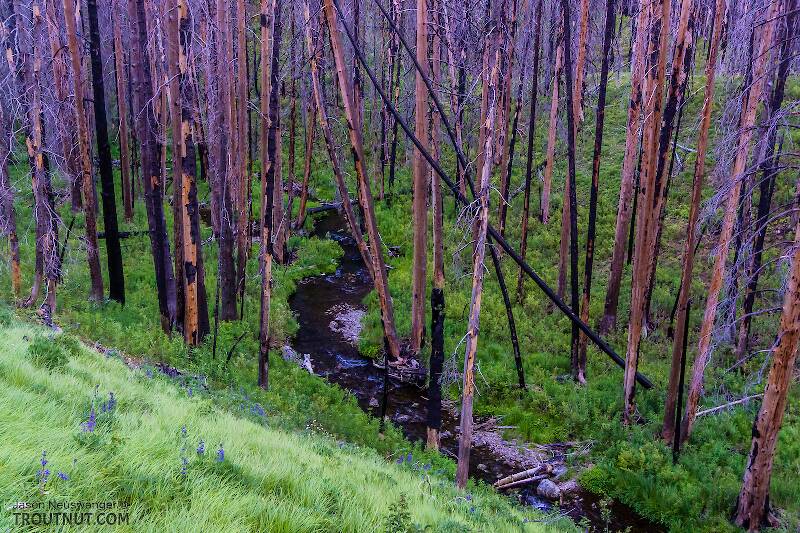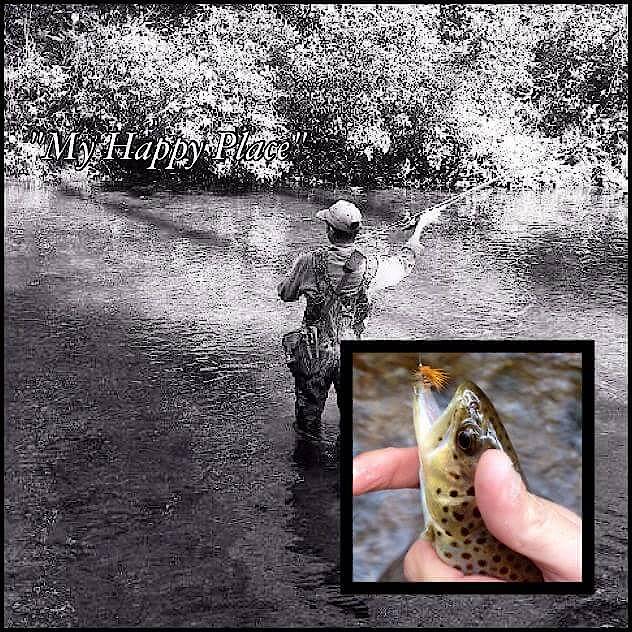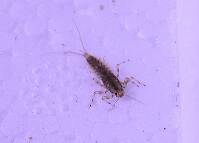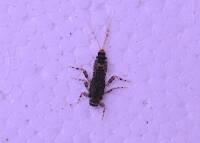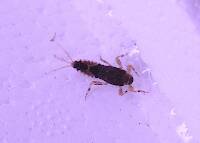
Hex Mayflies
Hexagenia limbata
The famous nocturnal Hex hatch of the Midwest (and a few other lucky locations) stirs to the surface mythically large brown trout that only touch streamers for the rest of the year.
Featured on the forum

This seems to be a young larva of Limnephilus. Although not clear in the picture, several ventral abdominal segments have chloride epithelia.

Troutnut is a project started in 2003 by salmonid ecologist Jason "Troutnut" Neuswanger to help anglers and
fly tyers unabashedly embrace the entomological side of the sport. Learn more about Troutnut or
support the project for an enhanced experience here.
Justin483 on Jan 12, 2015January 12th, 2015, 6:25 am EST
Hi everyone, first off my question:
Is there anyone on this page that could help me specifically with "Matching the Hatch" in North Georgia for the seasons? Or around North Georgia??? I'm having a problem finding insects and I'm still fairly new to the area. I haven't fished my local Stream long enough to have an educated guess on what the Trout might be feeding on for a specific season here in North Georgia. The local shop have been helpful to a certain extent, but let's face it, it gets embarrassing asking repeated questions over and over again. Smh. Please help me anyone if you can. I'm just a small time, very passionate Trout Angler who loves our fine Sport and who has been having a hard run of bad luck lately with this problem.
Secondly, I just wanna say I love the hospitality from everyone on this page so far. I'm new to this page and semi new to Fly Fishing. (About a year in religiously.) Thank you to all of you who take the time to help this frustrated Fly Fisherman out. Lol
- Justin Aldrich
Is there anyone on this page that could help me specifically with "Matching the Hatch" in North Georgia for the seasons? Or around North Georgia??? I'm having a problem finding insects and I'm still fairly new to the area. I haven't fished my local Stream long enough to have an educated guess on what the Trout might be feeding on for a specific season here in North Georgia. The local shop have been helpful to a certain extent, but let's face it, it gets embarrassing asking repeated questions over and over again. Smh. Please help me anyone if you can. I'm just a small time, very passionate Trout Angler who loves our fine Sport and who has been having a hard run of bad luck lately with this problem.
Secondly, I just wanna say I love the hospitality from everyone on this page so far. I'm new to this page and semi new to Fly Fishing. (About a year in religiously.) Thank you to all of you who take the time to help this frustrated Fly Fisherman out. Lol
- Justin Aldrich
PaulRoberts on Jan 12, 2015January 12th, 2015, 4:26 pm EST
Hi Justin,
To get an idea about your waters: In N GA you are probably talking about higher elevation brookie streams? Maybe some bows sprinkled in? These are mostly small high gradient streams? Any tailwater fishing (reservoir dam outflow) where you are?
To get an idea about your waters: In N GA you are probably talking about higher elevation brookie streams? Maybe some bows sprinkled in? These are mostly small high gradient streams? Any tailwater fishing (reservoir dam outflow) where you are?
Justin483 on Jan 12, 2015January 12th, 2015, 4:32 pm EST
My local Stream is the Soque River. (Public access, not the private paid sections.) But it's a Freestone stream, no tail waters. The stream is made up from several other smaller streams running into it, and it originates from a spring. The elevation is a bit higher than some, but there are mostly Browns and Rainbows in the stream I fish.
Thank you Paul for your time.
Thank you Paul for your time.
PaulRoberts on Jan 12, 2015January 12th, 2015, 4:44 pm EST
OK...just saw your other thread. Lots of good info there.
As to emergences likely in your area, start with the hatch charts. Since the Soque is an artificial fishery there may not be much help coming outta those lodges as those fish aren't eatin' local. Undoubtedly there are others flyfishers in N GA, maybe even some fly shops. Start there. Then go out into your streams and start looking in the riffles. Catch some critters and try to ID em. That's how you start. Gotta be curious. Then, as you prospect fish, watch for insect activity and trout feeding. This doesn't happen overnight. Gotta be there to see it and develop real questions.
As to right now, realize that there may be less going on mid winter insect wise. Come spring and summer you may find more. Most N GA waters are geologically infertile. May not be lots to find. But if there are trout, there are insects to feed em. Find out what your trout are eating. http://www.georgiawildlife.org/Fishing/Trout
As to emergences likely in your area, start with the hatch charts. Since the Soque is an artificial fishery there may not be much help coming outta those lodges as those fish aren't eatin' local. Undoubtedly there are others flyfishers in N GA, maybe even some fly shops. Start there. Then go out into your streams and start looking in the riffles. Catch some critters and try to ID em. That's how you start. Gotta be curious. Then, as you prospect fish, watch for insect activity and trout feeding. This doesn't happen overnight. Gotta be there to see it and develop real questions.
As to right now, realize that there may be less going on mid winter insect wise. Come spring and summer you may find more. Most N GA waters are geologically infertile. May not be lots to find. But if there are trout, there are insects to feed em. Find out what your trout are eating. http://www.georgiawildlife.org/Fishing/Trout
Justin483 on Jan 12, 2015January 12th, 2015, 4:49 pm EST
Ah, I get ya. I'll admit, I haven't been the most persistent about REALLY searching for insect activity. I mean dedicating my time specifically for that reason. I'm excited about it already. Thanks again Paul. Means a lot.
Crepuscular on Jan 13, 2015January 13th, 2015, 3:17 am EST
OK, I may come at this from a different perspective, but what I would do in addition to just going fishing (nothing replaces time on the water), is search the internet for macroinvertebrate surveys or water quality monitoring on the Soque. You may find a list of aquatic insects specific to your river. Remember you yourself said that you've only been at it for a year, Fly fishing may not take a long time to aquire a basic skill set, but it will take you a lifetime of learning and refinement. You may be looking for something that may not be available. Put your time in. Look at the Aquatic Insects here on Troutnut. If you really want to know about the aquatic species present in your Soque, go out and pick rocks, put the insects in water or alcohol on a bright background (Taxon has recommended a lid from a glass jar which is an excellent suggestion) get a point and shoot camera with macro capabilities and take some clear photos and post them here, most of the time we can get at least to genus level identification. You can also look on the internet for the mayflies, caddisflies of North Georgia/South Carolina. You will find species lists, you can cross reference those species with what is here on Troutnut. What will emerge is general times that you will find those insects present in the adult and immature life stages. Join the local chapter of TU and go to the meetings, you may find someone there willing to go fishing with you, or share some local knowledge.
Eric
Eric
Wbranch on Jan 13, 2015January 13th, 2015, 5:15 am EST
"Fly fishing may not take a long time to acquire a basic skill set, but it will take you a lifetime of learning and refinement"
I have been fly fishing for over half a century and while I catch a couple of fish I don't feel that I ever acquired the skills of some guys who have realty applied themselves to learn new techniques that will put more fish in the net. You do need to put in time actually fishing but you also must take time to observe how other guys are fishing especially if they are catching more fish than you are. Also when I was just a kid, in my early teens, I went to the public library and read everything I could get my hands on about fishing in general and later about fly fishing. There are hundreds of books out there devoted to the study of aquatic insects, their life cycles, all kinds of stuff that can help you grow as a fly fisher.
Hiring a guide is often appropriate if you are going on a major trip to a famous river in a far away state. You will already have spent a ton of money on air fare, car rental, lodging, meals, and license so another $400 is not going to break the bank. However since you are interested in learning about the aquatic life on your home river and how that knowledge will affect your success as a fly fisher do you really want some guide to hold your hand?
I think it will be much more fun and ultimately much more rewarding if you do it yourself. When I looked at pictures of the Soque I could see it is not a very wide, or deep, stream so you should be able to locate, examine, and study the aquatic insect life without very much risk to life or limb. I'd recommend (if it is legal in Georgia) that you go to a local Walmart or Home Depot and buy a piece of plastic mesh netting. The kind that window screens are made out of. It should be about 12" - 18" wide and about your outstretched arms long. You also need to buy two wooden dowels or stakes about 3/4" - 1" diameter and about 3' long. Attach the screen material to the wooden dowels and now you have a nice tool to catch the insects in the Soque.
What you want to do is get into the stream facing down with your back to the current. Then thrust the catch net into the water and try to get it down to the bottom and keep your arms outstretched to a comfortable distance. Then try shuffling your feet into the gravel on the stream bottom. It would make it a lot easier if you could get a buddy to stand in the stream above you (with you facing upstream) and shuffle the gravel and small rocks in the stream bed and then you just stand still below where he disturbed the stream bed and the dislodged insects will float downstream and get caught in your net.
Then you lift the net out of the water and go to the bank where you can view the insects and collect some in little bottles for future study or photography. Remember before you attempt this make sure it is legal in Georgia to collect insects from a stocked trout stream.
I have been fly fishing for over half a century and while I catch a couple of fish I don't feel that I ever acquired the skills of some guys who have realty applied themselves to learn new techniques that will put more fish in the net. You do need to put in time actually fishing but you also must take time to observe how other guys are fishing especially if they are catching more fish than you are. Also when I was just a kid, in my early teens, I went to the public library and read everything I could get my hands on about fishing in general and later about fly fishing. There are hundreds of books out there devoted to the study of aquatic insects, their life cycles, all kinds of stuff that can help you grow as a fly fisher.
Hiring a guide is often appropriate if you are going on a major trip to a famous river in a far away state. You will already have spent a ton of money on air fare, car rental, lodging, meals, and license so another $400 is not going to break the bank. However since you are interested in learning about the aquatic life on your home river and how that knowledge will affect your success as a fly fisher do you really want some guide to hold your hand?
I think it will be much more fun and ultimately much more rewarding if you do it yourself. When I looked at pictures of the Soque I could see it is not a very wide, or deep, stream so you should be able to locate, examine, and study the aquatic insect life without very much risk to life or limb. I'd recommend (if it is legal in Georgia) that you go to a local Walmart or Home Depot and buy a piece of plastic mesh netting. The kind that window screens are made out of. It should be about 12" - 18" wide and about your outstretched arms long. You also need to buy two wooden dowels or stakes about 3/4" - 1" diameter and about 3' long. Attach the screen material to the wooden dowels and now you have a nice tool to catch the insects in the Soque.
What you want to do is get into the stream facing down with your back to the current. Then thrust the catch net into the water and try to get it down to the bottom and keep your arms outstretched to a comfortable distance. Then try shuffling your feet into the gravel on the stream bottom. It would make it a lot easier if you could get a buddy to stand in the stream above you (with you facing upstream) and shuffle the gravel and small rocks in the stream bed and then you just stand still below where he disturbed the stream bed and the dislodged insects will float downstream and get caught in your net.
Then you lift the net out of the water and go to the bank where you can view the insects and collect some in little bottles for future study or photography. Remember before you attempt this make sure it is legal in Georgia to collect insects from a stocked trout stream.
Catskill fly fisher for fifty-five years.
Justin483 on Jan 13, 2015January 13th, 2015, 6:34 am EST
Great ideas Crepusculsar. Thank you so much.
Justin483 on Jan 13, 2015January 13th, 2015, 6:35 am EST
Thanks again Wbranch. Time in is ultimately best for sure. Great ideas.
Troutnut on Jan 13, 2015January 13th, 2015, 11:40 am EST
A colleague in Georgia told me most of those streams don't have intense hatches, so hatch-matching might not be your best bet, especially in a freestone stream. I'm obviously a big fan of hatch-matching when necessary, but the trout aren't always keying selectively on something. When that's the case, matching a common natural food isn't always your best bet to catch fish. You might do better with a fly with some unrealistic but attention-grabbing, lifelike features. Especially when you're reading the water and guessing where the fish are, it's good to use a fly they'll notice from a long distance as opposed to a subtle, realistic invitation that will go unnoticed (just like the real thing) unless it's close to the fish's nose. I would start out fishing attractor patterns I have confidence in, and then switch to something more subtle or realistic if I see fish inspecting and rejecting my fly.
Jason Neuswanger, Ph.D.
Troutnut and salmonid ecologist
Troutnut and salmonid ecologist
Wiflyfisher on Jan 13, 2015January 13th, 2015, 3:50 pm EST
You might try this forum.. http://www.itinerantangler.com/blog/board/forums/. There are quite a few knowledgeable fly fishers from the GA. area on the Itinerant Angler.
Also, I would learn to enjoy fly fishing for trout with various general searching patterns while you start to learn the hatches. IMHO. freestone streams are much different than a spring creeks and much easier to outwit a wily trout "most" of the time.
Also, I would learn to enjoy fly fishing for trout with various general searching patterns while you start to learn the hatches. IMHO. freestone streams are much different than a spring creeks and much easier to outwit a wily trout "most" of the time.
John S.
https://WiFlyFisher.com
https://WiFlyFisher.com
PaulRoberts on Jan 13, 2015January 13th, 2015, 4:12 pm EST
Good advice from Jason.
From the Georgia DNR site:
"Georgia's approximately 4,000 miles of trout streams are relatively unproductive when compared to streams found in other parts of the country. This is, in part, due to the calcium deficient soils found in north Georgia. Therefore, to meet the demands of over 100,000 trout anglers, stocking and special regulations are used on some streams to maintain acceptable catch rates. ..."
Almost anywhere you fish, you'll likely not be starting out "matching the hatch". A good book for you: "Prospecting for Trout" by Tom Rosenbauer. Match a hatch if and when you see one. That said, not all emergences are easy to see. And it can pay to know in advance what to look for. But that's down the road. Get to know your waters first. Learn to ID the bugs that are there. That's how to start. No rush (except that you are gonna die some day, so get busy. Trout fishing years aren't that long!) :)
From the Georgia DNR site:
"Georgia's approximately 4,000 miles of trout streams are relatively unproductive when compared to streams found in other parts of the country. This is, in part, due to the calcium deficient soils found in north Georgia. Therefore, to meet the demands of over 100,000 trout anglers, stocking and special regulations are used on some streams to maintain acceptable catch rates. ..."
Almost anywhere you fish, you'll likely not be starting out "matching the hatch". A good book for you: "Prospecting for Trout" by Tom Rosenbauer. Match a hatch if and when you see one. That said, not all emergences are easy to see. And it can pay to know in advance what to look for. But that's down the road. Get to know your waters first. Learn to ID the bugs that are there. That's how to start. No rush (except that you are gonna die some day, so get busy. Trout fishing years aren't that long!) :)
Justin483 on Jan 13, 2015January 13th, 2015, 5:10 pm EST
To EVERYONE:
I can't thank you enough for your time and enthusiasm. I do believe I have a few ideas now to help me along my way. All of you have helped get my ducks in a row so to speak. My mind has been so scattered just because I really had no idea where to start....because I've started so many times before. I think patience will help me in the future.
Thank you again for helping this Trout Fisherman along his way, and making it a little more pleasurable.
- Justin Aldrich
I can't thank you enough for your time and enthusiasm. I do believe I have a few ideas now to help me along my way. All of you have helped get my ducks in a row so to speak. My mind has been so scattered just because I really had no idea where to start....because I've started so many times before. I think patience will help me in the future.
Thank you again for helping this Trout Fisherman along his way, and making it a little more pleasurable.
- Justin Aldrich
Jmd123 on Jan 13, 2015January 13th, 2015, 6:03 pm EST
Justin, my 2 cents, from someone who once lived in the state of Georgia (Marietta to be exact, back in 2002)...
I have a book entitled "Trout Fishing in North Georgia" (3rd edition) by Jimmy Jacobs, 2001 (ISBN #1-56145-243-2). He doesn't go into a lot of detail on hatches but makes some general recommendations as to flies to have in your box(es). I can tell you from my fishing experiences on the Chattahoochee River in the north Atlanta area, and some forays further north, that Georgia trout like caddis flies, and cricket imitations! I had some good luck on a #10 Modified Joe's Hopper (an older pattern) tied in all-black with gray wings. In that part of the world, one can catch colorful rainbow trout and big slabside bluegill on these patterns out of the same holes (as I did a few times when I lived there, especially on a rocky tributary to the Chattahoochee).
As far as dry flies are concerned (my favorite method), the book I mentioned above recommends such patterns as Adams and Wulffs. Of course, these are some of my favorites so I concur, but they will most likely work well for you down there. Also, good old Woolly Buggers in a variety of colors plus your favorite streamers will also produce for you.
And don't neglect the sunfishies (I know they call them "bream" down there) and bass also on the fly rod, had some very good times with them also on the fly in GA!
Jonathon
I have a book entitled "Trout Fishing in North Georgia" (3rd edition) by Jimmy Jacobs, 2001 (ISBN #1-56145-243-2). He doesn't go into a lot of detail on hatches but makes some general recommendations as to flies to have in your box(es). I can tell you from my fishing experiences on the Chattahoochee River in the north Atlanta area, and some forays further north, that Georgia trout like caddis flies, and cricket imitations! I had some good luck on a #10 Modified Joe's Hopper (an older pattern) tied in all-black with gray wings. In that part of the world, one can catch colorful rainbow trout and big slabside bluegill on these patterns out of the same holes (as I did a few times when I lived there, especially on a rocky tributary to the Chattahoochee).
As far as dry flies are concerned (my favorite method), the book I mentioned above recommends such patterns as Adams and Wulffs. Of course, these are some of my favorites so I concur, but they will most likely work well for you down there. Also, good old Woolly Buggers in a variety of colors plus your favorite streamers will also produce for you.
And don't neglect the sunfishies (I know they call them "bream" down there) and bass also on the fly rod, had some very good times with them also on the fly in GA!
Jonathon
No matter how big the one you just caught is, there's always a bigger one out there somewhere...
Justin483 on Jan 13, 2015January 13th, 2015, 6:41 pm EST
Jonathon, your two cents was worth a heck of a lot more than that. The Elk Hair Caddis and various Caddis pupa/Larvae are what I've actually done my best on consistently here. I love going to the library here and checking out the Fly fishing and tying books. I'll make sure to look for the one you mentioned....good chance I've read it already. Lolol. I can't wait for spring cause I wanna get away from throwing the same old Elks Hair and I've heard nothing but good things about the Adam's and Wulffs. I know for a fact that the Trout in my stream see a TON of Elk Hair patterns thrown at them. So my thinking is to change it up on them a bit. And with the research I've done on those two patterns I'm feeling pretty confident and excited about using them this spring. And as far as Streamers, I'm a Streamer JUNKIE!!! LOVE EM. In the spring and summer I can always pull a couple on Streamers. No size Trout, but still fun all the same.
Thanks so much for giving me some of your time. It helped a bunch.
- Justin
Thanks so much for giving me some of your time. It helped a bunch.
- Justin
Quick Reply
Related Discussions
Topic
Replies
Last Reply
Re: Nice pictures of accompanying Epoicocladius sp. larvae
In Ephemera simulans Mayfly Nymph by Beardius
In Ephemera simulans Mayfly Nymph by Beardius
3
Aug 8, 2008
by Beardius
by Beardius
3
Sep 14, 2010
by Jmd123
by Jmd123
3
Oct 30, 2009
by Doublezz105
by Doublezz105

